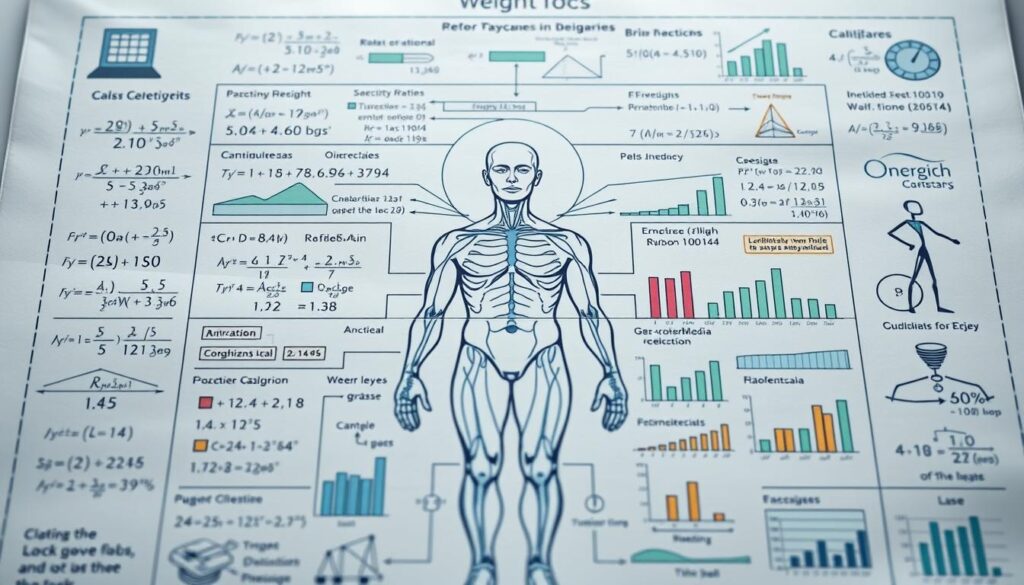How much should a man standing 5 feet 6 inches tall weigh to optimize health and longevity? While numbers on a scale matter, the answer involves more than simple math. Body composition, lifestyle factors, and clinical benchmarks all shape what’s considered a healthy range for this height.
Tools like BMI and standardized charts help professionals assess physical well-being. These resources correlate stature with mass to identify potential risks linked to being underweight or overweight. However, individual variability plays a critical role. Muscle density, bone structure, and even age influence where someone falls within these guidelines.
For men at this height, clinical evaluations often emphasize fat distribution patterns and metabolic markers alongside scale measurements. A balanced approach considers both quantitative data and qualitative health indicators. This ensures recommendations align with personal goals, whether improving athletic performance or reducing disease risks.
Key Takeaways
- BMI and height-weight charts provide baseline health assessment tools
- Muscle mass and body frame significantly impact ideal ranges
- Age-related metabolic changes affect weight management strategies
- Excess abdominal fat increases cardiovascular risks
- Standardized charts differ from personalized medical evaluations
- Lifestyle factors like diet quality matter more than scale numbers alone
Understanding Ideal Weight and Its Importance
Proper body composition serves as the foundation for physical resilience and energy efficiency. When our muscle-to-fat ratio stays balanced, organs function optimally, and daily tasks feel less taxing. Height-weight charts act as starting points for evaluating this balance, though they’re just one piece of the wellness puzzle.
Body Composition Shapes Health Outcomes
Muscle mass supports metabolism, while excess fat – especially around the waist – strains vital systems. Research shows that visceral fat increases risks for heart disease and diabetes, even if total body weight appears normal. This makes body fat percentage a critical metric alongside scale numbers.
Sustaining Balance Through Lifestyle Choices
Regular activity and nutrient-rich meals maintain structural harmony between tissues. For example, a height-weight chart might suggest a range, but individual needs vary based on bone density and fitness levels. Prioritizing whole foods over processed options helps manage fat storage patterns.
| Factor | Health Impact | Management Strategy |
|---|---|---|
| Muscle Mass | Boosts metabolism | Strength training 3x/week |
| Body Fat | Affects organ function | Monitor waist circumference |
| Bone Density | Supports frame structure | Calcium-rich diet |
| Water Weight | Influences scale readings | Track hydration patterns |
Clinicians often combine mass index calculations with blood work to create personalized plans. This dual approach addresses both visible measurements and internal biomarkers, ensuring recommendations align with biological realities rather than generic charts alone.
BMI and Weight Charts: Tools for Health Assessment
Healthcare professionals rely on two primary methods to evaluate physical health: BMI calculations and standardized charts. These tools offer objective starting points for assessing how body measurements align with population-wide health benchmarks.
How BMI Is Calculated and Interpreted
The Body Mass Index formula divides a person’s weight in kilograms by their height in meters squared. For example, someone weighing 68 kg at 1.68 meters tall has a BMI of 24.1 (68 ÷ 1.68²). Results fall into four categories:
- Under 18.5: Underweight
- 18.5–24.9: Healthy range
- 25–29.9: Overweight
- 30+: Obese
While useful for population studies, BMI doesn’t account for muscle mass or fat distribution. A muscular athlete might register as overweight despite having low body fat.
Utilizing Height-Weight Charts for Accurate Assessment
Standardized charts pair specific heights with weight ranges considered healthy. These visual guides help identify potential risks faster than raw numbers alone. For instance, a chart might show that 63-77 kg generally supports optimal health for someone measuring 5’6”.
However, these ranges assume average muscle mass and body frame. Those with denser bones or more lean tissue might healthily exceed chart recommendations. Regular self-checks using both tools provide clearer insights than single measurements.
Ideal weight for 5’6 male in kg
Standardized charts offer valuable guidance for assessing physical well-being at specific heights. For adults measuring 5 feet 6 inches, these tools reveal a typical range between 63 kg and 77 kg. This span accounts for natural variations in frame size and muscle development.
| Age Group | Weight Range (kg) | Body Frame | Notes |
|---|---|---|---|
| 20-35 | 63-70 | Small | Higher muscle mass may push upper limit |
| 36-50 | 67-74 | Medium | Focus shifts to fat distribution patterns |
| 51+ | 70-77 | Large | Metabolic changes necessitate adjustments |
Minor measurement discrepancies significantly impact health evaluations. A 2 cm error in height recording alters BMI calculations by 1.5 points. This underscores why clinics use calibrated equipment rather than self-reported data.
Reputable sources like the National Institutes of Health provide updated charts reflecting modern body composition research. These resources help distinguish between healthy mass and excess fat storage. Athletes often exceed standard ranges due to dense muscle tissue, while sedentary individuals might fall within “normal” numbers despite high body fat percentages.
Regular check-ups with healthcare providers ensure personalized assessments. They combine chart data with blood pressure readings and cholesterol levels for comprehensive health analysis.
Factors Affecting Your Ideal Weight
Your weight reflects a complex interplay of biological traits and lifestyle patterns. While charts provide general guidance, personal characteristics dictate where you thrive within those ranges. Let’s explore the key variables shaping individual health targets.
Biological Blueprint Matters
Age brings metabolic shifts that alter how we store fat and maintain muscle. Men naturally carry more lean tissue than women, while hormonal changes after 40 often redistribute body fat. These biological realities mean weight expectations should adjust over decades.
Body frame size – whether small, medium, or large – also influences healthy ranges. Dense bones add mass without health risks, while broader shoulders allow for higher muscle development. A tailored approach considers these structural differences when interpreting standard charts.
Tissue Composition Changes the Game
Muscle weighs more than fat but occupies less space. Two people at the same weight can have radically different health profiles based on their body fat percentage. This explains why athletes often exceed chart recommendations while remaining metabolically healthy.
| Factor | Impact on Weight | Actionable Insight |
|---|---|---|
| Age | Slows metabolism by 3-8% per decade | Adjust calorie intake gradually |
| Gender | Men have 5-10% more muscle mass | Use gender-specific charts |
| Body Frame | Adds 2-4 kg for large frames | Measure wrist circumference |
| Fat Distribution | Visceral fat triples health risks | Track waist-to-height ratio |
“There’s no universal ‘healthy’ weight – only weights that support individual wellness based on unique physiology.”
Practical weight management requires adapting strategies to your biological reality. Combining body composition analysis with lifestyle adjustments creates sustainable results. Regular progress checks ensure your approach evolves with changing needs.
How to Calculate Your Weight with Confidence
Taking charge of your health begins with understanding measurement fundamentals. We’ll break down two reliable methods to assess physical metrics – manual formulas and digital solutions.
Mastering Basic Measurement Formulas
Start with the BMI equation: weight (kg) divided by height (meters squared). For imperial measurements, use (weight in lbs × 703) ÷ height in inches squared. This calculation categorizes results into underweight, healthy, overweight, or obese ranges.
| Measurement System | Formula | Example |
|---|---|---|
| Metric | kg ÷ (m × m) | 70 kg ÷ (1.68 × 1.68) = 24.8 |
| Imperial | (lbs × 703) ÷ (in × in) | (154 × 703) ÷ (66 × 66) = 24.8 |
Record measurements three times for accuracy. Morning readings after bathroom use provide the most consistent data. Track changes monthly rather than daily for meaningful trends.
Harnessing Digital Tools Effectively
Online calculators like our BMI calculator for men automate complex math. These tools factor in age and activity levels, offering personalized ranges beyond basic charts.
Key advantages of digital solutions:
- Instant conversion between measurement systems
- Historical data tracking across years
- Integration with nutrition apps
Combine manual calculations with technology for comprehensive insights. Regular updates every 3-6 months help adjust targets as your body evolves.
Developing a Healthy Diet and Exercise Regimen
Fueling your body effectively requires more than calorie counting—it demands strategic nutrition paired with purposeful movement. Sustainable health emerges when food choices and physical activity work synergistically to support metabolic efficiency and tissue maintenance.
Nutritional Guidelines for Balanced Calorie Intake
Portion control and nutrient timing form the foundation of healthy eating. Focus on whole foods like leafy greens, lean proteins, and complex carbs to stabilize energy levels. A sample 2,000-calorie plan might include:
| Meal | Components | Key Benefits |
|---|---|---|
| Breakfast | Oatmeal + berries + almonds | Fiber & antioxidants |
| Lunch | Grilled chicken + quinoa + broccoli | Muscle repair & iron |
| Dinner | Salmon + sweet potato + asparagus | Omega-3s & vitamin A |
Hydration significantly impacts metabolic rate. Aim for 3-4 liters of water daily, adjusting for activity levels. Those targeting fat reduction should prioritize protein-rich snacks to curb cravings between meals.
Effective Exercise Routines to Complement Weight Management
Combine cardio and resistance training for optimal results. A weekly plan might alternate between:
- 30-minute brisk walks (5 days)
- Bodyweight circuits (2 days)
- Swimming or cycling (1-2 days)
Strength training preserves lean mass during weight loss, preventing metabolic slowdown. Focus on compound movements like push-ups and squats that engage multiple muscle groups simultaneously.
“Adults should get 150 minutes of moderate activity weekly and strength train major muscles twice weekly.”
Consistency trumps intensity. Small daily improvements—like taking stairs or stretching during work breaks—compound into lasting health benefits over time.
Monitoring and Adjusting Your Weight Over Time
Maintaining optimal physical well-being requires continuous attention to bodily changes. Regular check-ins help identify trends before they become problematic, creating opportunities for timely adjustments. This proactive approach combines measurable data with practical lifestyle modifications.
Effective Self-Assessment Strategies
Track three key metrics monthly: BMI, waist circumference, and clothing fit. These indicators reveal different aspects of body composition. For example, stable weight with shrinking waist suggests fat loss and muscle gain.
| Method | Frequency | Tools Needed | Key Insight |
|---|---|---|---|
| BMI Calculation | Monthly | Scale + tape measure | Identifies weight-height ratio shifts |
| Waist Measurement | Bi-weekly | Measuring tape | Highlights visceral fat changes |
| Body Fat Analysis | Quarterly | Smart scale or calipers | Reveals tissue composition |
| Progress Photos | Every 3 months | Camera | Visual documentation of changes |
Smart Adaptation Practices
When metrics plateau or trend unfavorably, modify calorie intake and activity levels by 10-15%. A gradual approach prevents metabolic shock. For instance, swap two sugary drinks weekly for herbal teas if aiming to lose weight.
Digital apps simplify tracking, but manual journaling provides deeper reflection. Combine both methods for comprehensive insights. Note energy levels and sleep quality alongside numerical data – these qualitative factors often explain quantitative changes.
“Successful weight management involves 80% consistency and 20% adjustment based on verified data.”
Update your health strategy annually to account for age-related metabolic shifts. Those over 40 might need more protein and resistance training to maintain muscle mass compared to younger adults.
Integrating Expert Advice and Practical Tools
Navigating health goals requires both personalized guidance and reliable resources. While charts and calculators provide general benchmarks, professionals interpret these tools through the lens of individual biology and lifestyle patterns.
Building Partnerships for Better Outcomes
Registered dietitians and certified trainers analyze body composition data to create actionable plans. For example, they might adjust calorie targets based on metabolic rate tests rather than generic formulas. Healthy weight management often involves:
- Blood work reviews to identify nutritional gaps
- Movement assessments for injury prevention
- Sleep quality evaluations impacting recovery
Case studies show adults working with experts achieve 30% better adherence to health plans. One 45-year-old reduced body fat by 8% in six months through tailored strength training and meal timing adjustments.
| Tool | Use Case | Expert Enhancement |
|---|---|---|
| BMI Calculator | Initial risk screening | Muscle mass adjustments |
| Food Tracker | Calorie monitoring | Nutrient balance analysis |
| Fitness App | Activity logging | Form correction tips |
“Combining self-monitoring tools with clinical expertise reduces misinterpretation risks by 42% in adults over 35.”
Regular consultations help refine strategies as bodies change with age or lifestyle shifts. This proactive approach helps prevent chronic conditions like hypertension before symptoms emerge.
Conclusion
Effective weight management combines scientific tools with personalized lifestyle adjustments. While standardized charts and body mass index provide baseline guidance, your unique biology determines what “healthy” looks like. Muscle composition, nutrition habits, and metabolic health all influence where you thrive within recommended ranges.
Regular use of validated tools like BMI calculators helps track progress and identify potential risks. Pair these metrics with waist measurements and energy-level assessments for a complete picture. Professionals often emphasize that consistency in diet and activity matters more than short-term scale fluctuations.
Explore our analysis of detailed height-weight charts to understand how age and frame size impact targets. Remember, sustainable health stems from balancing three pillars: nutrient-rich meals, purposeful movement, and expert-informed adjustments.
Revisit your strategy every 3-6 months as your body evolves. Small tweaks in protein intake or workout intensity often yield better results than drastic changes. Prioritize habits that enhance vitality over rigid numerical goals – true wellness always shows up beyond the scale.




